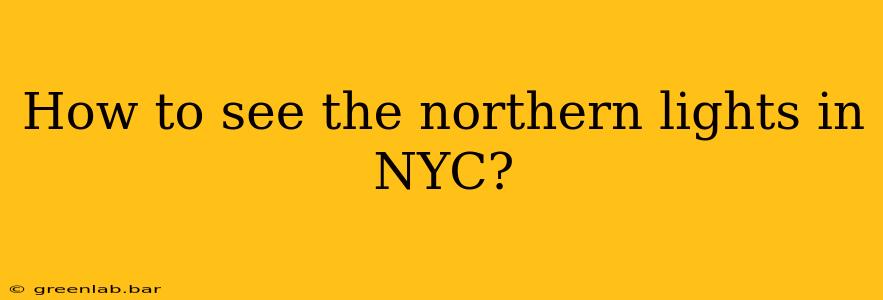Dreaming of witnessing the ethereal glow of the aurora borealis dancing across the night sky? While the Northern Lights are famously associated with high-latitude destinations like Alaska, Iceland, and Scandinavia, the idea of seeing them from the heart of New York City might seem like a fantasy. And, realistically, it is a very low probability event. However, let's explore the possibilities and what conditions would need to align for such a spectacular, once-in-a-lifetime sight to be visible from the Big Apple.
The Challenges of Aurora Viewing in NYC
Before we get into the "how," let's address the significant "why not." NYC's geographical location presents substantial hurdles:
- Light Pollution: The city's pervasive artificial light significantly drowns out the faint glow of the aurora. Even under ideal geomagnetic conditions, the aurora's luminosity might be too weak to overcome the brightness of city lights.
- Latitude: NYC sits at a relatively low latitude. The aurora borealis is most frequently visible at high latitudes near the Arctic Circle. The further south you go, the less likely you are to see the aurora, even during periods of intense solar activity.
- Atmospheric Conditions: Cloud cover, haze, and even humidity can obscure the aurora's visibility. A clear, dark night sky is crucial for observation.
When (and How) it Might Be Possible
While incredibly unlikely, there are scenarios where an exceptionally powerful geomagnetic storm could theoretically make the aurora visible from NYC. Here's what would need to happen:
- G1 or Higher Geomagnetic Storm: The aurora's intensity is directly correlated to the strength of geomagnetic storms. A G1 (minor) storm is unlikely to be visible from NYC, but a G4 (severe) or G5 (extreme) storm could potentially push the aurora far enough south. These events are relatively rare, happening only a few times a decade.
- Perfectly Clear Skies: Forget about city haze or clouds. You'd need exceptionally clear skies to even stand a chance.
- Minimal Light Pollution: Even with a powerful aurora, you'd need to escape the city's core to minimize light interference. Finding a spot far from skyscrapers and bright lights in the outer boroughs or even slightly beyond would significantly improve your chances (though still highly improbable).
- Precise Timing: Aurora displays are dynamic; they can appear and disappear quickly. You'd need to be monitoring aurora forecasts and be prepared to head outside immediately if conditions are favorable.
Where to Look (If You're Determined)
If you're determined to pursue this highly ambitious goal, consider these locations within and around NYC during a significant geomagnetic storm:
- Outer Boroughs: Head to the darkest parts of Staten Island, Queens, or Brooklyn, away from major light sources.
- Upstate New York: Locations further north in New York State would significantly increase your chances, though still low.
Realistic Alternatives: Aurora Viewing Elsewhere
Instead of pinning your hopes on a highly improbable event in NYC, consider planning a trip to a location known for its spectacular aurora displays. The investment will be far more likely to result in the unforgettable experience of witnessing the Northern Lights.
Conclusion: Embrace the Improbability (and the Alternatives)
Seeing the Northern Lights in NYC is a thrilling but exceptionally rare occurrence. While the possibility exists, the challenges are immense. Instead of focusing on the nearly impossible, why not plan a trip to a destination specifically known for the Aurora? It's a far more reliable way to experience this incredible natural phenomenon. This approach may be more certain, but it allows you to experience this breathtaking spectacle rather than hope for its improbable appearance in a city not known for its dark skies.

